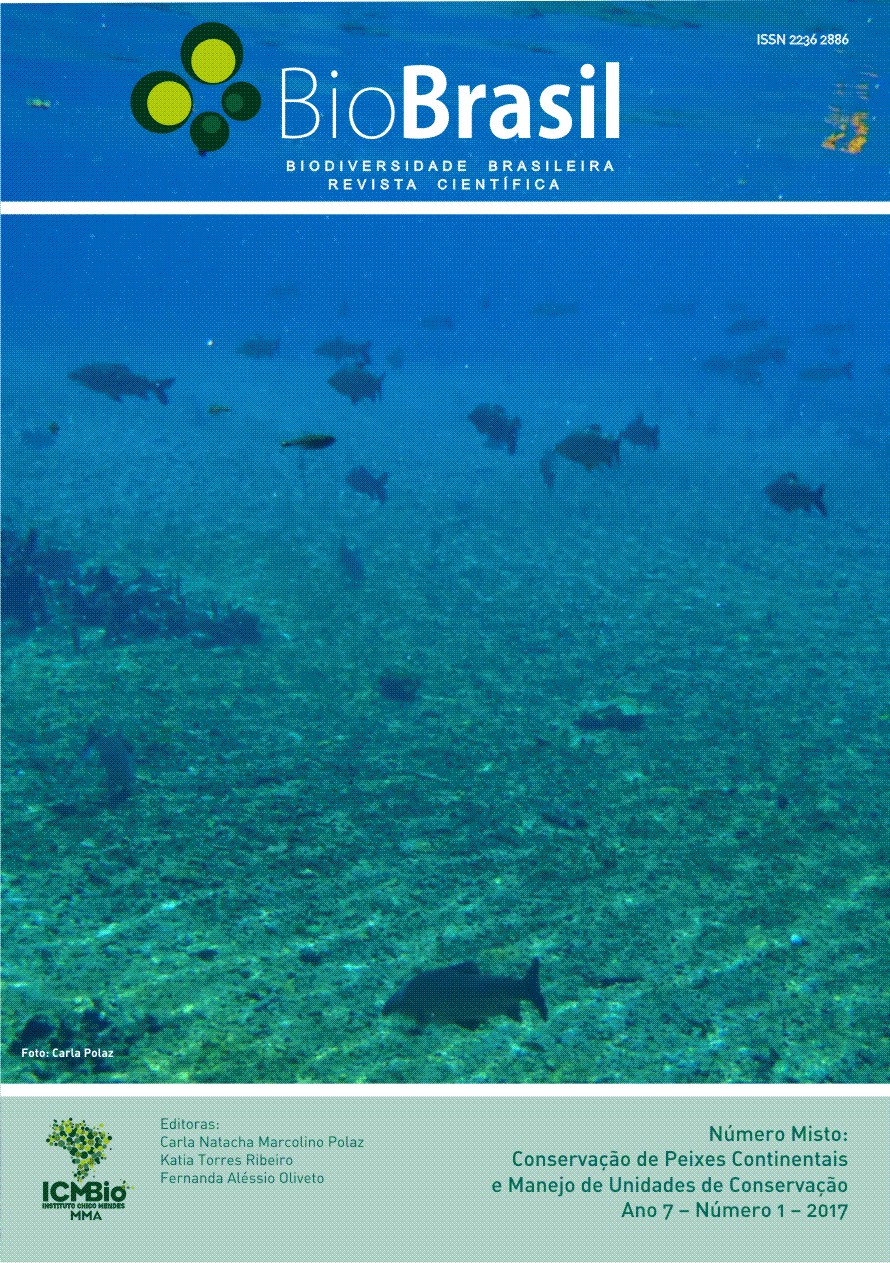Estimativa do tamanho de estoques pesqueiros da Amazônia baseada em dados de captura e esforço
DOI:
https://doi.org/10.37002/biodiversidadebrasileira.v7i1.617Palavras-chave:
Amazônia, pesca, capturabilidade, biodiversidade aquáticaResumo
As abordagens tradicionais para avaliação de estoques pesqueiros têm conduzido a resultados inapropriados, devido a um conjunto de premissas que ficam ocultas quando se representa um processo biológico por números. Neste trabalho uma abordagem alternativa é utilizada para avaliar o potencial pesqueiro total da Amazônia, lidando com a incerteza da capturabilidade através de um modelo probabilístico de mistura. Os resultados mostram que o potencial pesqueiro total da região amazônica é de, no mínimo, 200 mil toneladas anuais, confirmando resultados anteriores. Desta este trabalho sugere que é necessário utilizar abordagens probabilísticas que levem mais em conta a “fishmetics”, mas que o desafio dos pesquisadores é traduzir incerteza daí advinda de uma forma que seja útil para o processo de tomada de decisão sem comprometer o rigor científico no desenvolvimento da ciência da avaliação de estoque.Referências
Arreguín-Sanchez, F. 1996. Catchability: a key parameter for fish stock assessment. Reviews in Fish Biology and Fisheries, 6(2): 221-242.
Batista, V.S.; Isaac, V.J.; Fabré, N.N.; Gonzales, J.C.A.; Almeida, O.; Rivero, S. & Oliveira Jr, J.N. (org), 2012. Peixes e pesca no Solimões-Amazonas: uma avaliação integrada. IBAMA/ProVárzea, 276 p.
Baranov, T.I. 1918. On the question of the biological basis of fisheries. Nauchn Issledov. Ikhtiologicheskii Inst. Izv. 1: 81-128.
Bayley, P.B. 1983. Central Amazon fish populations: biomass, production and some dynamics characteristics. (PhD Thesis). Dalhousie University. 330 p.
Bayley, P.B. 1989. Aquatic environments in the Amazon Basin, with an analysis of carbon sources, fish production, and yield. In: Dodge, D.P. (ed.) Proc. International Large River Symposium (LARS). Canadian Special Publication of Fisheries and Aquatic Sciences, 106: 399-408.
Bayley, P.B. & Petrere 1989. Amazon fisheries: assessment methods, current status and management points. In: Dodge, D.P. (ed.). Proceedings of the International Large River Symposium. Canadian Special Publication of Fisheries and Aquatic Sciences, 106: 385-398.
Beverton, R.J.H. & Holt, S.J. 1957. On the Dynamics of Exploited Fish Populations. U.K. Ministry of Agriculture and Fisheries, Fisheries Investigations. 533p.
Chrysafi, A. & Kuparinen, A. 2015. Assessing abundance of populations with limited data: Lessons learned from data-poor fisheries stock assessment. Environmental Reviews, 1:1-44.
Dowling, N.A. et al. 2015. Empirical harvest strategies for data-poor fisheries: A review of the literature. Fisheries Research, 171: 141-153.
Ellis, N. & Wang, Y. 2007. Effects of fish density distribution and effort distribution. ICES Journal of Marine Science, 64: 178-191.
Francis, R.I.C.C.; Hurst, R.J. & Renwick, J.A. 2003. Quantifying annual variation in catchability for commercial and research fishing. Fishery Bulletin, 101(2): 293-304.
Fox, W.W. 1970. An exponential surplus-yield model for optimizing exploited fish populations. Trans. Am. Fish. Soc. 99: 80-88.
Gulland, J.A. 1977. Fish population dynamics. Wiley, 372 p.
Haddon.M. 2011. Modelling and Quantitative Methods in Fisheries. 2 Ed. CRC Press, 433p
Harley, S.J.; Myers, R.A. & Dunn, A. 2001. Is catch-per-unit-effort proportional to abundance? Can. J. Fish. Aquat. Sci. 58: 1760-1772
Instituto Brasileiro de Geografia e Estatístca - IBGE. 2017. Projeções e estimativas da população do Brasil e das Unidades da Federação. IBGE (Acesso em 18/02/2017).
Hashemi et al. 2014. Estimation of fish composition and catchability coefficient of gillnet in the Shadegan Wetland. Iran. J. Ichthyol., 1(1): 51-60.
Henderson, P.A. & Crampton, W.G.R. 1997. A comparison of fish diversity and abundance between nutrient -rich and nutrient-poor lakes in the Upper Amazon. Journal of Tropical Ecology, 13: 175-198.
Henderson, P.A. & Hamilton, H.F. 1995. Standing crop and distribution of fish indrifting and attached floating meadow within and Upper Amazonian varzea lake. Journal of Fish Biology, 47: 266-276. Hjort, J. 1914. Fluctuations in the great fisheries of northern Europe viewed in the light of biological research. Rapports ET Proce´s-verbaux des Re´unions du Conseil Permanent International pour l’exploration de la Mer, 20: 1-228.
Holt, S.J.; Gulland, J.A.; Taylor, C. & Kurit, S. 1959. A standard terminology and notation for fishery dynamics. ICES J Mar Sci. 24(2): 239-242.
Hosack, G.; Peters, G. & Ludsin, S. 2014. Interspecific relationships and environmentally driven catchabilities estimated from fisheries data. Canadian Journal of Fisheries and Aquatic Science, 71: 447-463.
Isaac, V. & Almeida, M.C. 2011. El consumo de pescado en la Amazonia Brasileña. COOPESCAALC Documento Ocasional N. 13, 43p.
Jiao, Y.; Reid, K. & Nudds, T. 2006. Variation in the catchability of yellow perch (Perca flavescens) in the fisheries of Lake Erie using a Bayesian error-in-variable approach. ICES Journal of Marine Science, 63(9): 1695-1704.
Thomé-Souza, M.J.F.; Raseira, M.B.; Ruffino, M.L.; Silva, C.O.; Batista, V.S.; Barthem, R.B. & Amaral, E.S.R. 2007. Estatística Pesqueira do Amazonas e Pará– 2004. IBAMA/ProVárzea, 74 p.
Thorson, J.T. et al. 2013. A new role for effort dynamics in the theory of harvested populations and datapoor stock assessment. Canadian Journal of Fisheries and Aquatic Sciences, 70(12): 1829-1844.
Velázquez-Abunader, I.; Salas, S. & Cabrera, M.A. 2013. Differential Catchability by Zone, Fleet, and Size: The Case of the Red Octopus (Octopus maya) and Common Octopus (Octopus vulgaris) Fishery in Yucatan, Mexico. Journal of Shellfish Research, 32(3): 845-854.
Villegas-Ríos, D. et al. 2014. Life-history and activity shape catchability in a sedentary fish. Marine Ecology Progress Series, 515: 239-250.
Welcomme, R.L. 2001. Inland Fisheries Ecology and Management. Fishing New Books, Blackwell Science, FAO, 357p. Wilberg, M.J. et al. 2009. Incorporating time-varying catchability into population dynamic stock assessment models. Reviews in Fisheries Science, 18(1): 7-24.
Zhou, S. et al. 2011. Estimating multifleet catchability coefficients and natural mortality from fishery catch and effort data: comparison of Bayesian state-space and observation error models. Canadian Journal of Fisheries and Aquatic Sciences, 68(7): 1171-1181.
Downloads
Publicado
Edição
Seção
Licença
Copyright (c) 2021 Biodiversidade Brasileira - BioBrasil

Este trabalho está licenciado sob uma licença Creative Commons Attribution-NonCommercial-NoDerivatives 4.0 International License.
Os artigos estão licenciados sob uma licença Creative Commons Atribuição-NãoComercial-SemDerivações 4.0 Internacional (CC BY-NC-ND 4.0). O acesso é livre e gratuito para download e leitura, ou seja, é permitido copiar e redistribuir o material em qualquer mídia ou formato.





 v3-3-0-3-2-1-8-release.27
v3-3-0-3-2-1-8-release.27